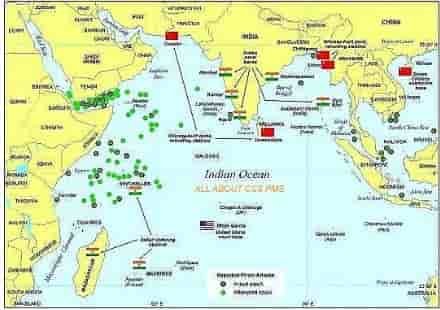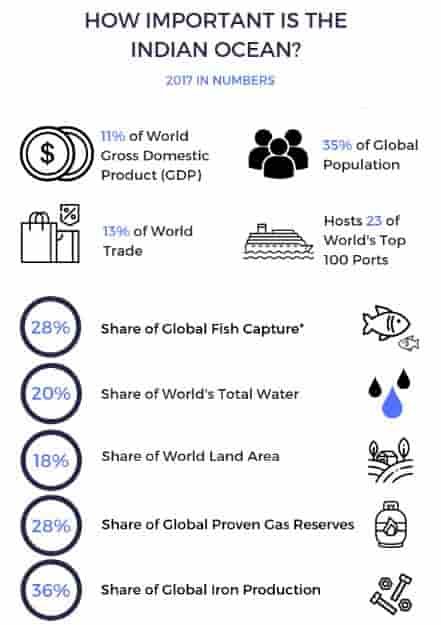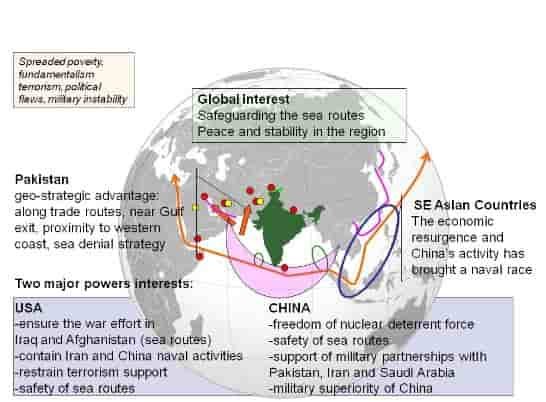INDIAN OCEAN : MAJOR POWER COMPETITION
Introduction
"Whoever rules the waves, rules the world"
Alfred Thayer Maha
- The Indian Ocean, the third-largest water body, has always remained a center of attention among different superpowers.
- Its geostrategic, economic, and political significance has inspired many countries to control this region.
- Historically, various Global powers attempted to dominate this region, including the Chinese, Portuguese, Britain, Americans, and Indians. Similarly, the post-cold War world order is again seeing a rise in competition among major Global powers-the US, China, Russia, India and Pakistan in the Indian Ocean, owing to its vital aforementioned importance.
- Meanwhile, the nature of interests varies from state to state in the form of economics, geopolitics, and geostrategic levels.

Significance of the Indian Ocean
The significance of the Indian Ocean are as follows :
- The Indian Ocean is the third largest of the world's oceanic divisions with an area of 70.56 million kilometers.
- It consists of 36 states around its coastal belt and 11 hinterland states.
- Moreover; It also includes a diversity of races, cultures, and religions.
- Along with these, the most important chokepoints i.e. the Suez Canal, the Strait of Hormuz, Bab-el-Mandeb, the Cape of Good Hope, and the Straits of Malacca are also part of this water body.
- Similarly, it is the hub of four major world continents i.e. Asia, Australia, Africa, and Europe.
- Perhaps because of this, the Indian Ocean Region has been considered an arena of major power rivalry and global geopolitics.

Major Competing Powers and their Interests in the Indian Ocean
The major competing powers and their interests in the Indian Ocean are
- United States of America
- Peoples Republic of China
- Russia
- India
- Pakistan
1. United States of America: A Status quo power
- The US, being a superpower, seriously feels any change in the geostrategic configuration of this region by rising power China.
- The US has decided to contain the rising power of China in the Pacific and the Indian Oceans through different alliances and harmonious states.
- Moreover, the initiation of the Chinese-led Road and Belt Initiative (BRI) and its flagship program China-Pakistan Economic Corridor (CPEC) has materialized the perceived threat of the US.
- It is a reason that the US is taking advantage of its full energy to control the Indian Ocean region by itself or its allies.
- It is collaborating with Indian Ocean seaside states, particularly India, and also modernizing QUAD-in Indian Ocean Region.
- Moreover, it also intends to exert a carrot-and-stick policy towards Pakistan to become its ally in the region against China.
- To sum up, the US has major stakes in the Indian Ocean region against the rising power of China and it plans to detain China at any cost and maintain the status quo in the region as well in the world.
2. Peoples Republic of China: A Revisionist Power
- Indian Ocean region (IOR) has direct vital importance for China mainly because its estimated more than 90 percent of oil-importing travels in this region from the Middle East.
- Indian Ocean Region (IOR) has also become significant for China because of its disputes in the South China Sea.
- US, with help of its allies, especially QUAD(India, Australia, Japan and the United States of America), is a big threat for China in the Pacific region therefore it wanted alternative routes through Indian Ocean.
- It is one of the logics behind the initiation of BRI (Belt and Road Initiative) and CPEC (China Pakistan Economic Corridor), which can become natural and safe routes for Chinese imports all around the world.
- Moreover, BRI has wide over reach all over the world because it bridge different continents through roads and maritime routes.
- As a major part of the BRI crosses through IOR, China must maintain supremacy in the region.
- But a major limitation that hampers the aims of China is that it is not the natural part of this region, therefore, it has to depend on other states i.e. Pakistan.
- Thus, China considers IOR as the top concern because of BRI and to contain US strategies against her.
3. Russia: A Return to South Asia
- Russia's "Return to South Asia" refers to cultivating warm relations with both Pakistan and India.
- Russia is also considered the major competitor in IOR owing to its historical legacy and domination.
- Russia under the leadership of its president Vladimir Putin is reviving and trying to grab the media attention of world politics.
- Therefore, Russia is advancing towards South Asia with special reference to India and Pakistan for economic and strategic reasons i.e. selling of weapons and other commercial items.
- Moreover, historically, Russia, the former USSR, has played a very important role during the cold war period as it was directly taking part in the politics of this region.
- During the cold war, USSR and USA competed in Indian Ocean waters, their submarines accomplished different missions against each other.
- Thus, Russian revival and return to the South Asian region eventually will lead her to come to IOR which may cause involvement for other regional actors.
4. India: An ambitious littoral state
- It is the major nuclear stakeholder coastal state in the Indian Ocean and it sees itself as the natural leading regional power in the Indian Ocean.
- India has managed the Indian Ocean as its "backyard", instead, some maritime scholar believes it a "front yard" owing to its geography, territory, and control.
- Moreover, India is collaborating with the US against China and Pakistan in maritime affairs.
- Similarly. it is developing its navy by adding aircraft carriers and launching of nuclear submarine Arihant, which has seriously terrorized the nuclear configuration of the sub-continent region due to achieving second-strike nuclear capability.
- In a nutshell, Indian maritime aims in IOR can seriously shake the peaceful security environment of the Indian Ocean region and can lead to a big catastrophe as well.

Implications on Pakistan
1. Strategic level
- Pakistan shares a 990km long coastline with the Arabian Sea and is among the major coastal states of IOR.
- Its Western coast adjacent to the Gulf makes it of strategic importance for providing the shortest, established, and secure sea route to the landlocked Central Asian Republics(CARs), East Asia, European and Pacific nations, Afghanistan, and the Western province of China through Gwadar Port.
- Furthermore, due to China's Belt and Road Initiative (BRI) and CPEC, the India Ocean assumes even greater significance for Pakistan.
- Meanwhile, Indian maritime ambitions to subdue the role of Pakistan through sabotaging CPEC can be a serious strategic security concern as well as challenge for Pakistan.
2. Economic level
- Pakistan is greatly dependent on the Indian Ocean with about 95 per cent of its trade through the sea.
- Mostly its petroleum, oil, and lubricants supplies are also shipped in through the Arabian Sea.
- Moreover, the Gwadar Port also provides the facility of being a hub for oil and gas pipelines linking the Central Asian region, Middle East, Africa, and Europe well through the Suez Canal.
- Any competition in IOR can either trigger a security threshold or hamper peaceful economic environment that can directly impact Pakistan.
- Therefore, peace and safety in 1OR are crucial for Pakistan.
3. Political level
This major power competition in IOR has serious political indications for Pakistan.
In this regard, it will be demanding for Pakistan to choose one side if the US-China rivalry gets worst in a given circumstances.
Pakistan cannot leave China due to geography and economic bind whereas it also cannot straightly go against the United States due to structural limitations i.e. IMF, FATF, and other financial regimes.
Recommendations
- A technologically modern and highly equipped naval force has become a terrible need of Pakistan.
- The completion of CPEC and Gwadar Port should be magnify without any further delay.
- Pakistan should more focus on naval consultation as well as on the remodeling of the naval force.


